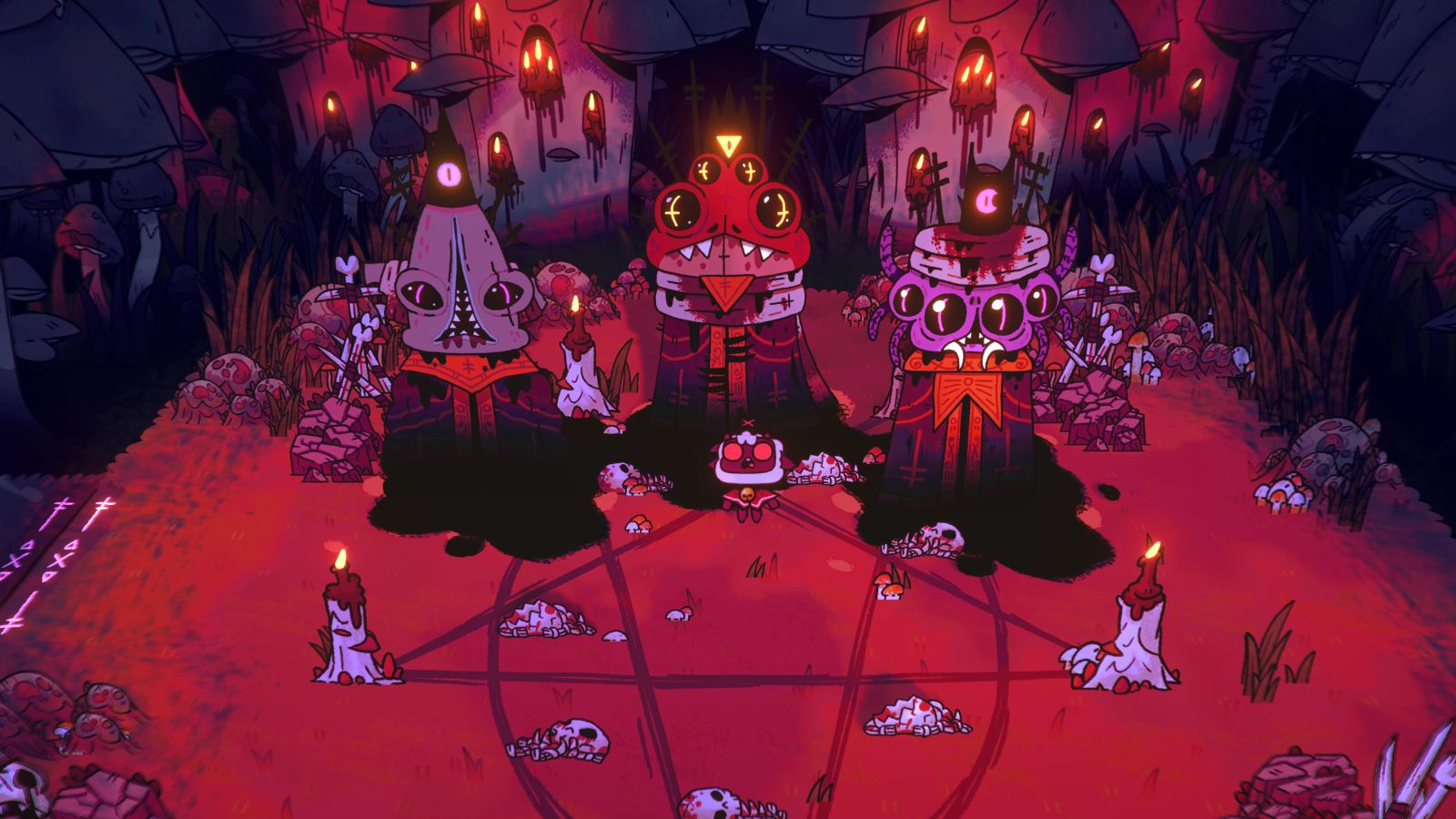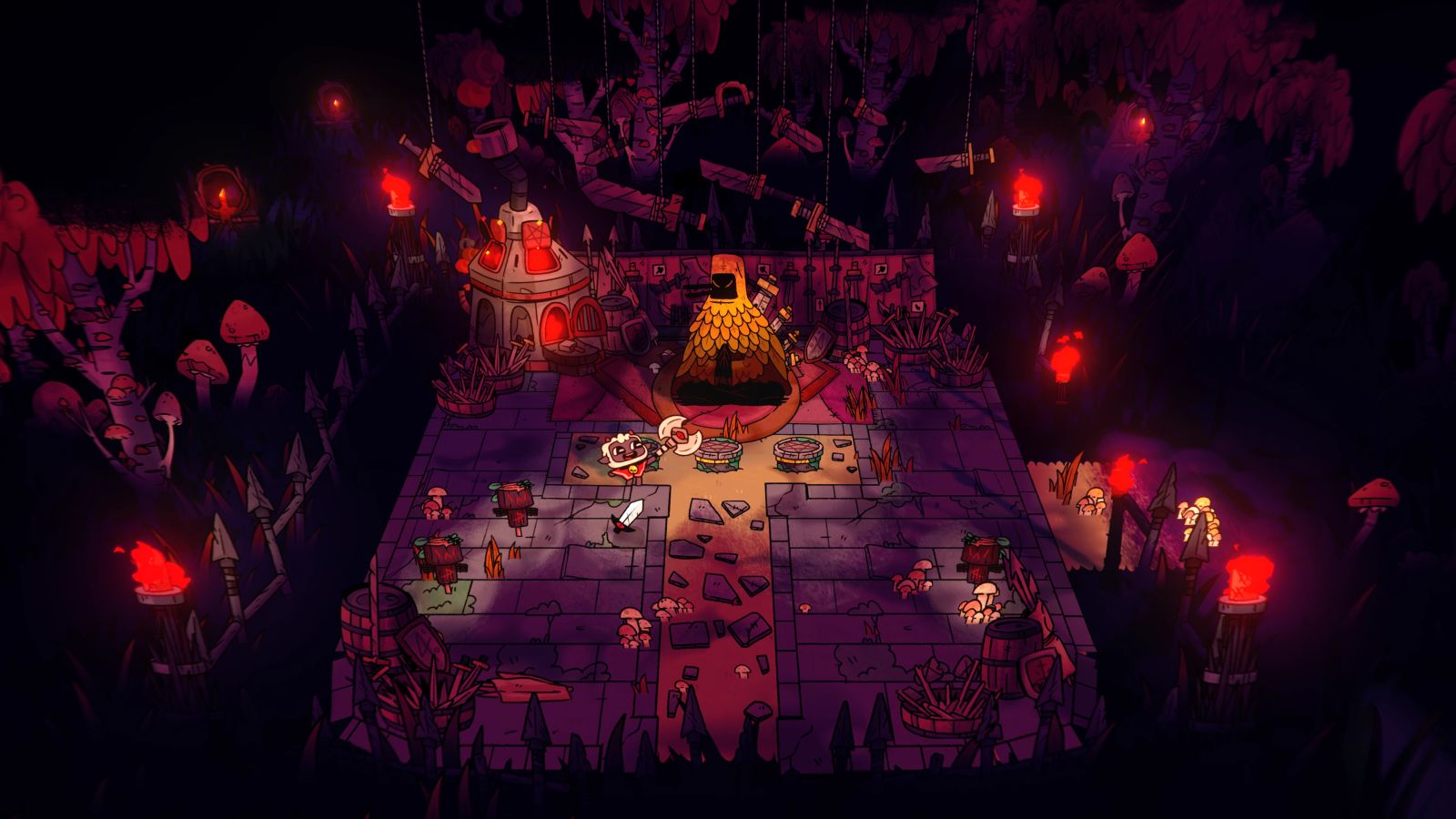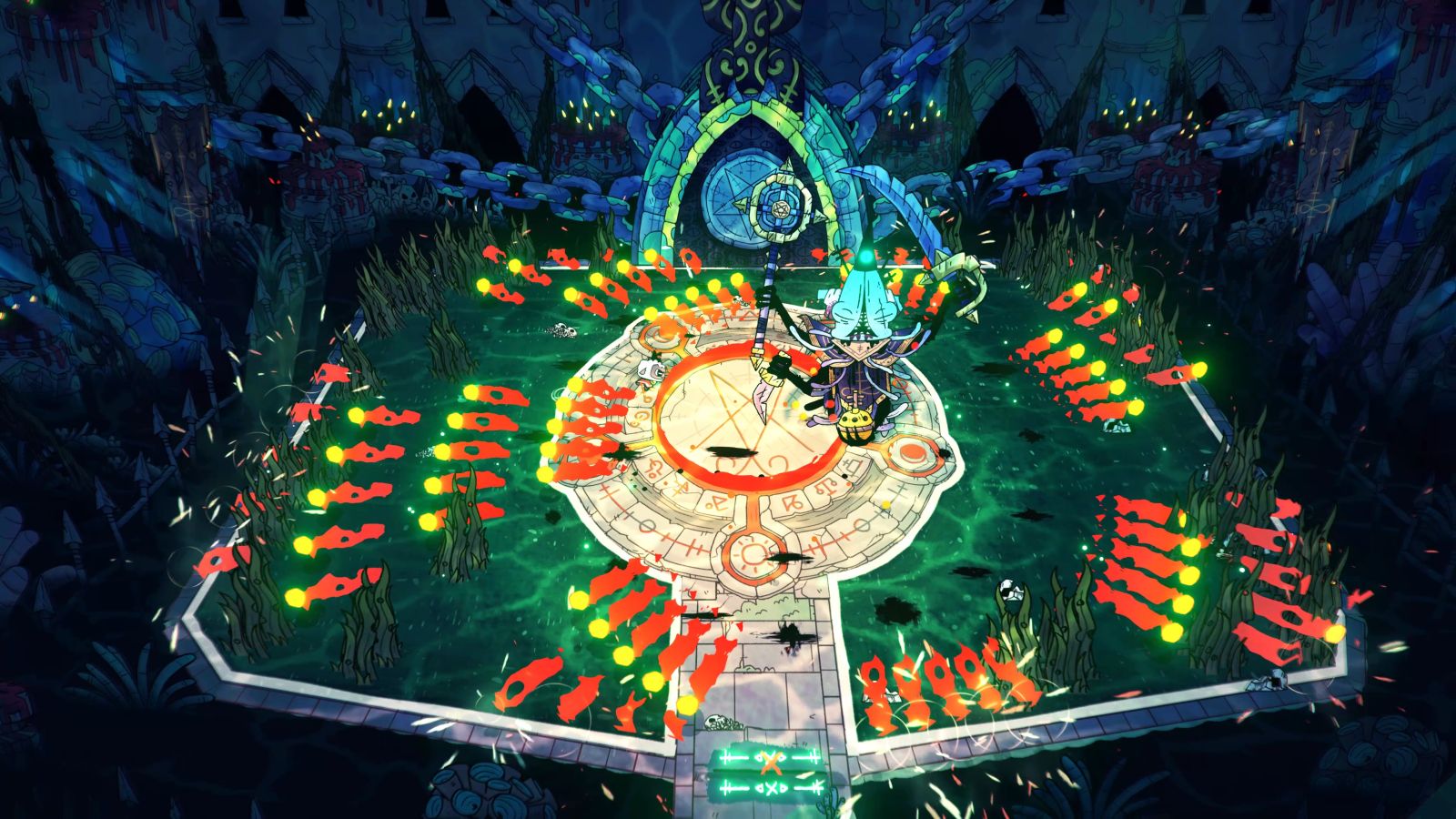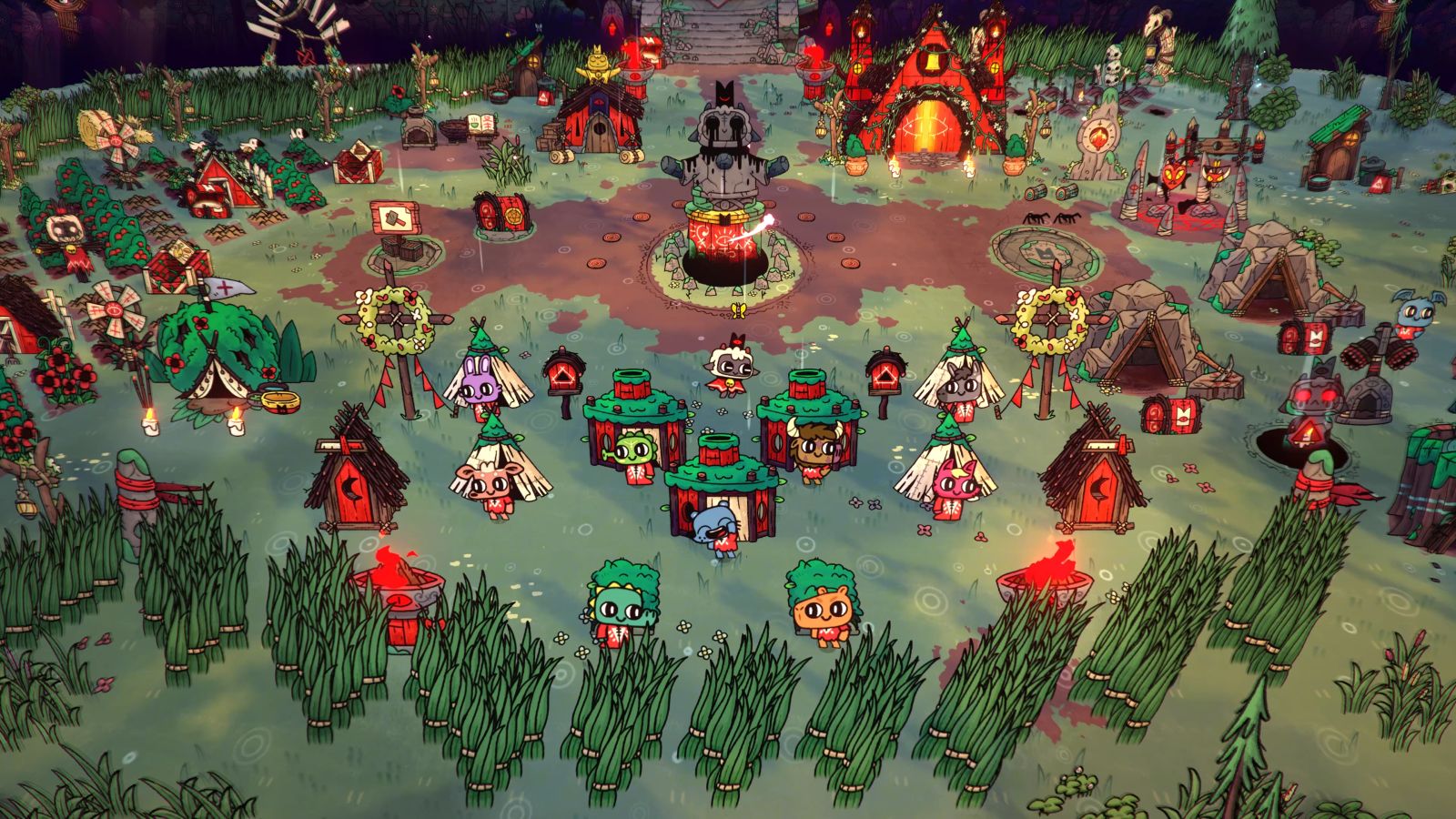
Running a cult is hard work – your followers are just so damned needy. They want things like food, shelter, a place to relieve themselves, and even healthcare! Sure, they are devoted, but they also get sick, disgruntled, and eventually die, stinking up the place. Sure, your converts all look up to you, but you were brought back in an unholy ritual that spared you from death by a massive chained creature. Turns out, everybody’s got a boss. What does he want? Well, the destruction of his enemies, of course! Let’s get on it, little lamb – there’s a cult to run.
I didn’t misspeak – your journey as leader of the Cult of Lamb starts as cultists death march you towards a sacrificial altar to be culled as the last of your kind. As the blade comes down, you find yourself transported to…somewhere else. Face to face with a new deity than the ones who had just condemned you, you find yourself thrust into a new job as leader of a cult. As representative of “The One Who Waits”, you now find yourself the tip of the spear in its bid to take down his four rivals. I mean, given that your choices in the matter are “Yes” and “Absolutely”, you’ve chosen wisely, haven’t ya?
There are four Bishops of the Old Faith – Bishop Heket, a multi-eyed frog beast, Bishop Kallamar, a…I dunno how to describe it, Bishop Leshy, which looks like a bloody rag wrapped around a bush, and Shamura – the ruler of the other three. Your job, as bestowed by your new deity, is to destroy each and every one of them.

At its core, Cult of the Lamb is a roguelike that combines some of the best examples of the genre into one amazingly cohesive irreverently odd action title. There are four bosses you’ll need to battle, but it’s not as straightforward as heading out there to kick their teeth in. No, you’ll need to build your powerbase, and that means finding minions you can convert to your cause. They may be woodland creatures that are about to be sacrificed, eagerly joining your cult because you saved their life, or a cute little creature being cocooned by a spider who is willing to sell them to you instead. Even inside every boss is actually a cute little critter trapped in a possessed form, freed by the whipping you’ll put on them.
Once you’ve returned to your haven, you’ll find your rescued critters waiting to be indoctrinated. At this point you can change literally every aspect of their existence – just like a real cult! Their name, appearance, color, shape – everything except some inherited traits, such as being skittish or prone to sickness. From there, you’ll pick how they’ll best contribute to the cult. They can worship a central idol, farm crops for food, chop wood, mine rocks, and much more in your service.
Collecting worship allows you to unlock your Divine Inspirations. These are things like sleeping bags and farming plots for your minions at the lower levels, refineries, healing bays and fertilizer silos in the mid tier, and advanced harvesting and better outhouses at the top. There are four tiers in all, giving you plenty to tinker with as you set up your haven to be the most efficient it can be.
Heading out of your haven you’ll find four doors representing the four gods you must defeat on your quest. It’s very much like another fun recent roguelike, Moonlighter, in that way. Heading inside you’ll be presented with the tools of your trade – weapons and curses chosen at random. A Bane Dagger I, for instance, can do a small amount of damage, but is very quick and has a chance of poisoning the target – compensation for the short range. Divine Blast I will knock back enemies within range while also damaging them. These weapons are far from your only tools of the trade, however, as you’ll also find plenty of Tarot Cards along the way.

Progressing through the level, you’ll eventually reach a fork in the road. Presented as a map not unlike Slay the Spire, you’ll choose a path that leads to resources, a follower, new weapons, food, or a mystery location designated with a question mark. You’ll occasionally encounter Forneus, an odd cat-like creature that runs a pop-up stand to sell resources, or a giant red tent of a bird-beast named Clauneck. It will draw forth two Tarot Cards that provide a choice – boons if you will. One side might cause curses to consume less Fervour (the blood droplets that power your curses, and their spelling, not mine), and the other might allow you to trigger an area of effect attack on every hit. There are 36 in all, and with a roadmap that extends into the future, so I can imagine developer Massive Monster expanding these Tarot Cards post-launch.
Curses are insanely useful in Cult of the Lamb. These can manifest in a number of ways including ranged attacks, area of effect spells, flinging giant tentacles, and much, much more to turn the tide against your foes. By collecting the manifestations of your sermons, you’ll unlock new powers and weapons that can spawn randomly within each dungeon, not unlike Dead Cells, with easily twice as much variety. Most importantly these can provide reach that your weapons may lack.
At the end of each run you’ll be presented with a summary of how well you did. How many things you collected, enemies you swatted, and how long you took to do it are tallied, along with any bonuses you may have earned. For example, you get a tidy 20% bonus to your items if you didn’t take any damage when fighting the area boss.

There are difficulty levels from easy, normal, hard, and very hard to choose from in Cult of the Lamb, and you can change at will if you need to match your expectations. It starts out easy enough, but soon you’ll have an absolute cavalcade of color and speed on your screen as you dodge and slice your way through an increasingly large number of very tough foes. Frankly, it’s the only negative for the game – it can occasionally be a challenge to see what’s going on with all of the bombastic particle effects and bullet-hell baddies. Beating a boss means returning to those areas is kicked up a notch for additional difficulty for future runs. It keeps things fresh as foes will pick up new powers and longer health bars. As powerful as you might get, your enemies are legion, and they will give you a run for your money. Since your little lamb has no blocking skills, you’ll be dodge-rolling your way to victory, lest you find yourself martyred. Dying makes your cult lose faith that you have what it takes to lead them, so try not to do it too frequently.
When your faith drops too low, you may develop Dissenters. These traitors will spread falsehoods about you and lead other followers astray. You can re-educate them by strapping them into various torture implements, imprisoning them, or simply sacrificing them. You run the joint, so you do you. On the flip side of Dissenters are your true believers. As you inspire, bribe, or otherwise cajole your minions to believe in your cause, they will periodically “level up” and devote themselves fully to the execution of your will. This will also yield stone fragments that when combined will provide a Commandment. Commandments can be turned into Doctrines.

Doctrines are the upgrade path for your Red Crown, but also how you further control your flock. These can give you powers like letting you warp back to base, sacrificing a minion to bring yourself back to life while on a run, or providing a feast to refill the bellies of your cultists. Additional Doctrines include reassuring your minions that death is not the end, increasing their work and worship outputs, spreading law and order, focusing on the value of earthly goods, and having your minions “focus on the liturgies surrounding their daily bread”. Each of these will unlock another choice that will effectively become law. Using the last one as an example, you can instruct your followers to fast, meaning they will not eat or be hungry for three days, or you can throw them a grand feast which will result in a +25 faith boost. These are involet as they are unchangeable, so choose wisely.
Your followers will periodically ask for things. Sometimes it’s as simple as adding some pretty decorations, and sometimes they think it’d be hilarious if they made another devotee eat poop as a prank. After a while, they tend to escalate, with some of your most devout followers asking that you sacrifice them to The One Who Waits to better serve the flock. You are in charge, so you can choose to ply them with gifts, outright bribes, or other special activities to reinforce their faith in your cause, but generally it’s a good idea to keep them happy and provide what they want. Sure, you are in charge, but only if you’ve got followers, right?
Everything you encounter in Cult of the Lamb is useful. Flowers, grass, rocks, logs, seeds – even the bones of the enemies you cut down can be turned into useful ritual materials. This ties directly into the base building mechanic that will occupy all of your time outside of dungeon runs. Your cult is threadbare and with little in the way of resources. Your dungeon runs will light the first candles, allowing you to slowly bring your cult to life. Logging and mining camps provide resources, and your ever-expanding farms will help feed your flock. Continue to gather the devotion of your penitent peons and you’ll unlock new blueprints to help your small cult grow, providing basics like sanitation, prisons, farms and support buildings. I don’t want to ruin these for you, and the game is thankfully cagey with your upgrade paths as well, so enjoy uncovering the many ways you’ll retain control of your brainwashed brigade.

There are a lot of interlinking systems in Cult of the Lamb, each feeding into the needs of one another. They are doled out over time, so you never feel overwhelmed. It ties into one of the things I love about Cult of the Lamb most – it’s bite sized. Early levels can be mere minutes, and longer runs are rarely longer than 30. A day in your camp feels like a good distraction that sticks around for precisely as long as it needs to before effectively kicking you back out on your adventures to gather more materials. There’s even fishing and a gambling minigame called Knucklebones where you can earn some extra coin as you play a math-based risk/reward puzzle game that is far more fun than I anticipated it would be. Each distraction is another bite sized chunk to keep things interesting. Honestly, there’s so much I’ve left out, including brainwashing rituals and more. On the surface it can feel like a lot, but taking it in stride and understanding that these are just there to break up your runs makes it all digestible. For me, I just enjoy a break from all the wanton murder and bone-crushing to do a little fishing. It’s therapeutic, and every good cult needs a tasty fish stew every now and again.
A full run of Cult of the Lamb will run you around 15 hours, and you can add another 7-10 if you take your time. That doesn’t account for the myriad of choices that are either A or B and can’t be switched, so there’s a potential to go back and run the game again with an entirely different approach. Maybe you were a benevolent overlord in the first game, offering up feasts and ascending your minions before they drop dead to honor them. Maybe you run it a second time as a tyrant, feeding your minions literal bowls of their own poop and sacrificing them for a boost to your own power at the cost of their loyalty. After all, loyalty can be found at the end of a long stretch in prison if they get too far out of hand. The choices are many, but they do feel like they all add up to pretty fine-grained control over your fiefdom.
If all of this sounds like a love letter to Cult of the Lamb, it’s pretty accurate to my time with the game. It’s obnoxiously cute, with your chibi-esque woodland creatures offering wide-eyed adulation at every turn. Even when they get angry they look insanely cute. Sacrificing them to an Eldritch god at your altar is really the only time they look rather worried for their precarious position. It’s an odd blend of saccharin and occult that is unique, even if it combined familiar component parts of so many others in the genre. Roguelikes and colony builders aren’t precisely rare, but Cult of the Lamb manages to combine them in a way that will challenge your reflexes, as well as your minion management skills.
Cult of the Lamb
Excellent
A top-tier example of what a roguelike can be when combined with a colony sim, Cult of the Lamb is pure addiction. From managing your minions, to slaughtering the bizarre Eldritch gods that dare defy you, Cult of the Lamb has converted me completely.
Pros
- Cuteness overload juxtaposed with Eldritch horror
- The soundtrack is equally as twisted cutesy
- Excellent genre blend of roguelike and colony builder
- Meaningful management choices add replay
- Doesn’t overstay its welcome at 15-20 hours
- Roadmap ahead for additional content
Cons
- Can occasionally be visually overwhelming
